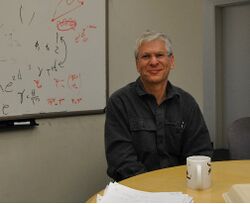Biography:Stephen Shenker
From HandWiki
Short description: American physicist
Stephen Shenker | |
|---|---|
 | |
| Born | 1953[1] |
| Nationality | United States |
| Alma mater | Harvard University (B.A.) Cornell University (Ph.D.) |
| Known for | string theory phase transitions |
| Awards | MacArthur Fellowship American Academy of Arts and Sciences Lars Onsager Prize (2010) National Academy of Sciences |
| Scientific career | |
| Fields | theoretical physics |
| Institutions | Stanford University Rutgers University University of Chicago |
| Doctoral advisor | John Kogut |
| Doctoral students | Joanne Cohn Matthew Kleban |
Stephen Hart Shenker (born 1953) is an United States theoretical physicist who works on string theory. He is a professor at Stanford University and former director of the Stanford Institute for Theoretical Physics. His brother Scott Shenker is a computer scientist.
Work
Shenker's contributions to physics include:
- Basic results on the phase structure of gauge theories (with Eduardo Fradkin)
- Basic results on two dimensional conformal field theory and its relation to string theory (with Daniel Friedan, Emil Martinec, Zongan Qiu, and others)
- The nonperturbative formulation of matrix models of low-dimensional string theory, the first nonperturbative definitions of string theory (with Michael R. Douglas)
- The discovery of distinctively stringy nonperturbative effects in string theory, later understood to be caused by D-branes. These effects play a major role in string dynamics
- The discovery of Matrix Theory, the first nonperturbative definition of String/M theory in a physical number of dimensions. Matrix Theory (see Matrix string theory) is an example of a gauge/gravity duality and is now understood to be a special case of the AdS/CFT correspondence (with Tom Banks, Willy Fischler and Leonard Susskind)
- Basic results on the connection between quantum gravity and quantum chaos (with Douglas Stanford, Juan Maldacena and others)
Selected works
- Fidkowski, Lukasz; Hubeny, Veronika; Kleban, Matthew; Shenker, Stephen (6 February 2004). "The Black Hole Singularity in AdS/CFT". Journal of High Energy Physics 2004 (2): 014. doi:10.1088/1126-6708/2004/02/014. Bibcode: 2004JHEP...02..014F.
References
External links

